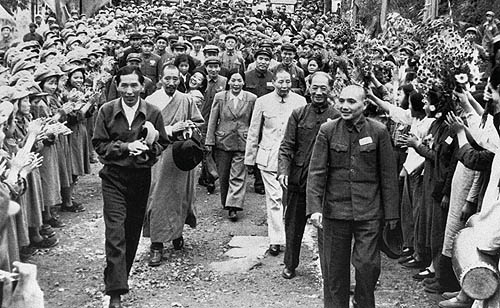|

When the People's Republic of China was founded on October 1, 1949, the 10th Panchen Erdeni, one of the two major Living Buddhas in Tibet, announced his support for the Central Government and his wish to see early liberation of Tibet.
On May 23, 1951, the Agreement Between the Central Government and the Local Government of Tibet on Measures for the Peaceful Liberation of Tibet was signed in Beijing. As the agreement contains 17 articles, it is often referred to as the 17-Article Agreement. The 14th Dalai Lama and the 10th Panchen Erdeni both cabled the Central Government, expressing their support for the agreement and their determination to safeguard the unity of the sovereignty of the motherland. Tibet won peaceful liberation in accordance with the agreement.
The 14th Dalai Lama and the 10th Panchen Erdeni attended the first National People's Congress of the PRC. And the 14th Dalai Lama was elected a vice-chairman of the NPC Standing Committee, and the 10th Panchen Erdeni a member of the NPC Standing Committee. On April 22, 1956, the Preparatory Committee for the Founding of the Tibet Autonomous Region was set up in Lhasa, with the 14th Dalai Lama serving its director and the 10th Panchen Erdeni its first deputy director.
Reform is a principle that was contained in the 17-Article Agreement. But the ruling class in Tibet still clung to feudal serfdom, which had been abolished for some 100 years in Europe, as something indispensable for Tibet. They fought tenaciously with the Central Government and the progressive forces in Tibet over whether the 17-Article Agreement should be implemented. On March 10, 1959, the reactionary slave owners declared publicly "the independence of Tibet" and staged an armed rebellion. On March 28, the Central Government announced abolition of the local Gaxag government of Tibet, and the Preparatory Committee for the Founding of the Tibet Autonomous Region took over governance in the region.
The Preparatory Committee for the Founding of the Tibet Autonomous Region passed in June and September 1959 the Resolution on Democratic Reform in the Whole Area of Tibet and the Resolution on Abolition of Feudal Serf-Ownership of Land and Introduction of Farmer Land Ownership, deciding to fully arouse the masses to action and carry out the Democratic Reform throughout the region. The reform was completed at the end of 1961, and various counties, districts and townships set up their people's power organs.
In March 1962, 92 percent of the townships conducted elections on the basis of establishing Peasants Association. From July to August 1965, election at the county-level was completed. The First Session of the First People's Congress of the Tibet Autonomous Region was held from September 1-9, 1965 in Lhasa, and the Tibet Autonomous Region was proclaimed as having been founded. | 